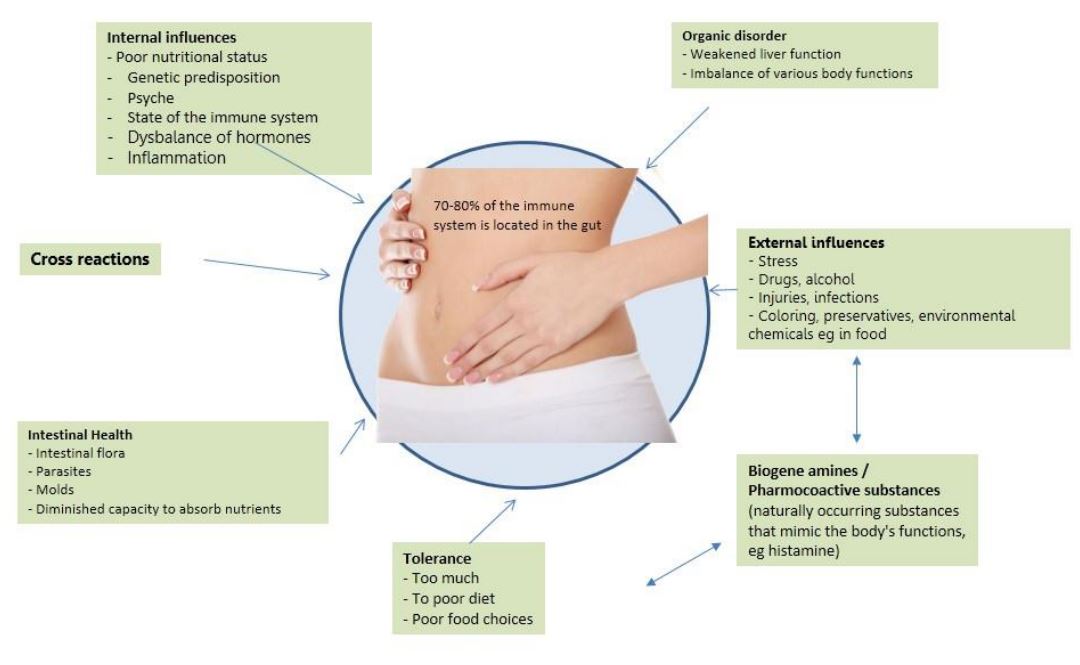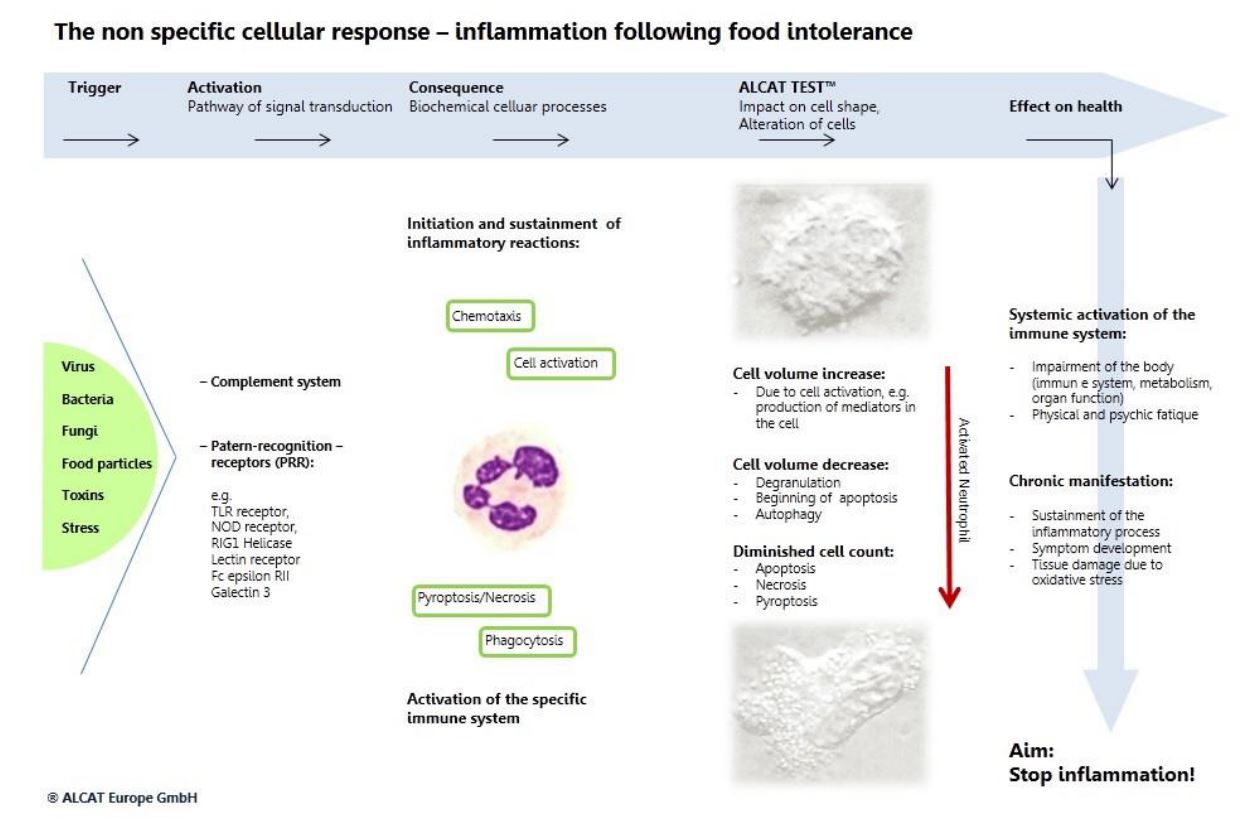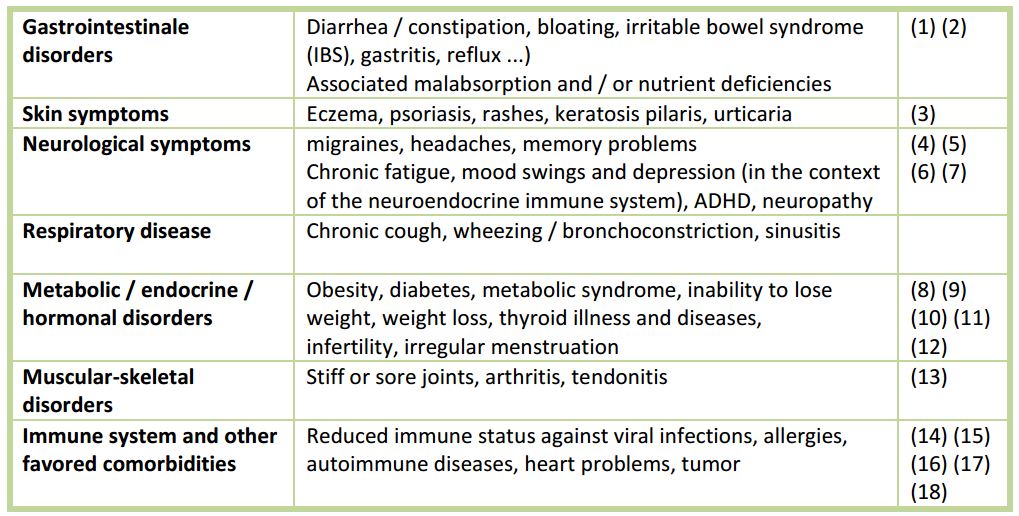Dr. ner. rat. Silvia Slazenger
Inflammatory diseases and degenerative processes have greatly increased in the last decades and parallel the industrialization of food and modern life style. According to the GEK health report 2011 the most common disease of the German population is high blood pressure followed by depression and metabolic disorders such as diabetes 2 and over weight. Atopic disorders affect 5 -20%, about 50% of those patients suffer from atopic eczema. A 2010 survey of the Society for Nutrition Therapy and Prevention e.V. reported that 67% of respondents suffer from intermittent or persistent gastrointestinal symptoms including bloating or abdominal pain after eating. An important cause may be food intolerance, which is mediated by the innate immune system. It leads to typical adverse reactions and inflammatory processes. Defense reactions, e.g. of neutrophils, create the basis for micro inflammation and centres of inflammation. The whole system is a very effective first defense strategy against acute infections but chronic activation will lead to health disorders. A study by the University of Pavia in 2011 on 48 patients with gastrointestinal disorders (GI) and 35 patients with skin problems (H) illustrates the influence of incompatible foods in the body: the not tolerated substances were removed from the diet, improved symptoms after 2 months significant at 71% (GI) and 66% (H) of the patients.
The role of the immune system
The immune system consists of three barriers, that are based on each other and protect from disease (Fig.1).
Figure 1: Functional structure of the immune system, © Alcat Europe GmbH
1. The barrier corresponds to a kind of coarse filter that catches potential germs by mechanical or biological barriers.
2. The barrier includes a directional response of the body. The cells of the innate immune system are the evolutionarily oldest part of our immune defense. They attack all substances and germs, which are not endogenous or molecular patterns (antigens) that are recognized as pathogenic and therefore not being tolerated. This type of immune response is a kind of vanguard, an initial “firewall” that is intended to eliminate invading pathogens within minutes or initiate further combat creating inflammation.
3. The barrier, the adaptive immune system, which is comprised of specialized cells and their products, detects pathogens and infected cells and directs attacks against same utilizing customized antibodies and response to specific molecular patterns on cell surfaces.
The gut contains an estimated 70-80% of the immune system: With almost 400m ² it is the largest contact area with the external world. Around the intestine a simultaneously extensive lymphoid tissue (GALT, gut-associated lymphoid tissue) that forms the largest immune organ in our body.
Causes of Food Intolerance
Various influences, which the immune system is exposed (see Figure 2), which can decide between “alien / dangerous” and “self / harmless” disrupt and normally harmless dietary components put an immune reaction.
Figure 2: The causes for a disturbed immune balance can be diverse, © Alcat Europe GmbH
Specific immunity – Allergy
In classic food allergies type 1, the specific immune response (third barrier) plays the lead role. After repeated antigen contact the body responds with an excessive reaction (IgE antibodies, histamine release). The symptoms are dramatic and acute as of sneezing, coughing, watery eyes, skin rash, nausea and even anaphylactic shock. The occurrence of true food allergies in Germany is approximately 2.5% (BMG, 2004).
Innate immunity – differentiation from allergy
Food intolerance mediated by the innate immune response (second barrier) happens often. Specific pattern recognition receptors in the cell membrane (Toll-like receptors; TLR) or in the cytoplasm (NOD-like receptors) of immune cells initiate the release of an inflammatory cascade (Fig. 3). NODS involved, inter alia, in the formation of the inflammasome. This is a protein complex, which is responsible for the maturation of interleukins and thus inflammation proactively sets in motion. Neutrophils mainly play an important role in this process, since they make up almost 70% of the leukocytes. Activated granulocytes produce reactive enzymes inside the cell (e.g. myeloperoxidase) and radical oxygen molecules, which they distribute to combat the foreign substance. Thus, the cell volume increases initially until the cells degranulate finally on to dismiss these biochemical cocktail into the tissue. In addition, they send out chemokines (messengers) to fetch other immune cells to help. The ground is prepared for inflammation.
Figure 3: Inflammatory reaction cascade of the innate immune system
Innate immune defense and systemic inflammation
The consequences of food-induced activation of the immune system can initially be subtle, but may become serious over time. The continuous intake of reactive substances causes local micro-inflammation in the intestinal tissue, which spreads insidiously and can manifest itself in other tissues. Therefore the ormonal-, the nervous and the metabolic system can be affected and symptoms may manifest in varioush forms. This makes it complex and symptoms might not be identified with food intolerance as the initial cause.
Table 1: Examples of diseases that are associated with food intolerance and activated innate immunity and
inflammation, © Alcat Europe GmbH
The list in table 1 reflects the experience of doctors from various disciplines and demonstrates the enormous variety of impacts of an underlined chronic, food induced immune activation resulting in associated inflammatory processes. Often, in addition to a present (main) intolerance, over time other intolerances may occur resulting in multiple intolerances influencing each other adversely.
Diagnostic Approaches
In cases of suspected food intolerance should be investigated various parameters, such as eating habits and cravings, environmental conditions, stress, fatigue, health status of the gut, inflammation maker (e.g. CRP), etc. This results in a first indication of the nature and cause of intolerance. The cause of a lactose, gluten and fructose intolerance can be enzymatically (lactase deficiency) or genetic (eg, GLUT-5-fructose malabsorption, celiac disease). There are specific and well-known testing methods (H2 breath test, antibody test, stool test, etc.).
In a possible genetic food intolerance, the therapist should also keep in mind that genetic defects do not necessarily have to appear phenotypically and they can also be variable. What matters is what happens at the epigenetic level. A significant example is the study by Professor Fasano to celiac disease, potential celiac disease and gluten sensitivity, in which the same genetic factors lead to different phenotypes and severity of the expression (1).
Also, there are different approaches of blood testing to identify an immunologically mediated food intolerance beyond allergy. Well known are blood tests that measure the presence of IgG antibodies and thus conclude due to the presence that there must be an incompatibility to that food. However, the role of IgG associated food intolerance is scientifically discussed controversially. Various studies have shown that IgG rather play a protective role (14).
Another blood test, the Alcat Test™ considers an immune response in the wholeness. Here too, various food extracts and also chemical additives and drugs can be individually tested. This test is used for around 25 years in the United States in hospitals and by doctors and was confirmed by double-blind studies in its benefits and its significance (15). However, it is the only functional test of this kind that analyses the immediate reaction of immune cells of the innate immune system while the complex intracellular interaction in the fresh whole blood sample remains (16). The biochemical responses of these cells are as described above, largely responsible for the initiation of inflammation.
Case studies from various fields – Identification and dietary management of food intolerance
Case Study 1
Skin Courtesy of Dr. Fiorenzo Angehrn, Director of Clinic Piano, Biel, Switzerland Specialist for surgery and phlebology SGP.
The pictures show a patient with atopic dermatitis who was treated with an elimination and rotation diet after identifying incompatible foods (Alcat Test™).
Figure 4 Skin condition before treatment and 14 weeks later. Above: Ultrasound / Collagenosom ®, Below: Photograph
History
Patient with eczema in different body areas.
Treatment
Identification of food intolerance (Alcat Test ™) and elimination / rotation diet.
Treatment success
Freedom from symptoms after 14 weeks. The skin thickness and the skin density with the corresponding collagen crosslinking points in the dermis (OHD-value) has been documented with the 22 MHz ultrasound Osteoson Collagenoson® type “ICU” (Minhorst) The outer skin system is immunologically related to the intestinal mucosal system, the “inner skin”. Therefore, disturbances in the gut often show as skin blemishes, acne or skin conditions such as eczema, atopic dermatitis and urticaria
Case Study 2
Pancreatitis
Courtesy of HP Angela Käßner, Knesebeckstraße 27, 10623 Berlin, naturopath, lecturer
History
Patient, 47 years old, had two years increasingly repeatedly upper abdominal pain. Multiple hospitalization, gastroscopy, colonoscopy, CT, MRI, conventional laboratory analyzes – all with negative results. Painkiller without effect.
Diagnosis and therapy
Suspicion that food intolerance may maintain the chronic pancreatitis. No conventional medical tests available, therefore IgG test and Alcat Test to identify food intolerance.
Treatment success
Compliance with the Alcat Test diet brought freedom of pain and symptoms. In contrast, the responsible highly reactive foods were not detected with the IgG test. After the diet phase (regeneration and supporting immune balance), the majority of the reactive foods could be re-introduced again into the diet.
Case Study 3
Multiple symptoms: Over weight / Rheumatoid Arthritis
Courtesy of Dr. David Blyweiss, Private Practice, Boca Raton, Florida
History
Patient, 54 years old, 162cm, 77kg, with a diagnosis of rheumatoid arthritis. Drug treatment with Humira, Methotrexate, Enbrel and Prednisolone. Still no pain relief and side effects of strong medications.
Symptoms
Joint pain, fatigue, cold intolerance, insomnia, teeth marks in the swollen tongue periphery, rheumatoid swelling in the finger joints leading to handle complaints.
Therapy
Food intolerance test and strict eliminations-/rotational diet led to a strong improvement of symptoms in between 6 months. After 9 months the patient felt only in the morning or after gardening pain in the right hip. She also lost about 17 kg of weight, blood levels became normal.
Conclusion
Immune-mediated food intolerance and associated inflammation are often not recognized as the cause of various symptoms, the more as so as delayed reactions make the identification complex and difficult.
The consequence of food intolerance may be serious long term conditions such as metabolic syndrome, neurological disorders, immunological comorbidities and others. Case studies from different fields have shown that an individually tailored rotation- and elimination diet after the identification of reactive substances alleviate symptoms or even completely restore health even in cases where a drug treatment was unsuccessful or no abnormal organic cause was diagnosed.
The treatment of various inflammatory disorders with additional dietary modification thus provides a valuable, complementary therapy approach. This article is intended to stimulate the professional interdisciplinary exchange on the various manifestations of food intolerance its identification and dietary management.
Literature
(1) Sapone, A. et al: Divergence of gut permeability and mucosal immune gene expression in two gluten-associated conditions: celiac disease and gluten sensitivity. BMC Medicine, 9:23; 2011
(2) Fell, P. et al: Cellular Responses to Food in Irritable Bowel Syndrome – An Investigation of the ALCAT Test. Journal of Nutritional Medicine, 2, 143-149; 1991
(3) Berardi, L. et al: Food intolerance in patients with cutaneous diseases: diagnostic value of the Alcat test. Presentation at the 30th Congress of the European Academy of Allergy and Clinical Immunology, 11-15 June 2011 – Istanbul, Turkey
(4) Samaroo D. et al: Novel immune response to gluten in individuals with schizophrenia. Schizophr Res, 118:248-55; 2010
(5) Dickerson F. et al: Markers of gluten sensitivity in acute mania: A longitudinal study. Psychiatry Res, 196:68-71; 2012
(6) Vitte J et al: Oxidative stress levels in circulating neutrophils is linked to neurodegenerative diseases. J Clin Immunol, 24(6):683-92; 2004
(7) Oodegard JI et al: Connecting Type 1 and Type 2 Diabetes through Innate Immunity. Cold Spring Harb Perspect Med, 2(3); 2012
(8) Duncan BB et al: Chronic activation of the innate immune system may underlie the metabolic syndrome. Sao Paulo Med J, 119:3; 2001
(9) Bastard JP et al: Recent advances in the relationship between obesity, inflammation, and insulin resistance. Eur Cytokine Netw, 17(1):4-12; 2006
(10) Miesel R et al: Priming of NADPH oxidase by tumor necrosis factor alpha in patients with inflammatory and autoimmune rheumatic diseases. Inflammation, 20(4):427-38; 1996
(11) Tlaskalova-Hogenova et al: Involvement of innate immunity in the development of inflammatory and autoimmune diseases. Ann N Y Acad Sci,1051:787-98; 2005
(12) Wan-Wan L et. Al: A cytokine-mediated link between innate immunity, inflammation and cancer. J Clin Invest, 117(5):1175-1183; 2007
(13) Poon BY et al: alpha(4)-integrin mediates neutrophil-induced free radical injury to cardiac myocytes. J Cell Biol 152(5):857-66; 2001
(14) Stapel SO et al: Testing for IgG4 against foods is not recommended as a diagnostic tool: EAACI Task Force Report. Allergy, 63:793–796; 2008
(15) Fell PJ et al: High correlation of the ALCAT test results with double-blind challenge (DBC) in food sensitivity. Ann Allergy. 62:253; 1989
(16) Kaats G et al: The Short Term Efficacy of the ALCAT Test of Food Sensitivities to Facilitate Changes in Body Composition and Self-Reported Disease Symptoms: A Randomized Controlled Study. Am J of Bariatric Med, Spring: 18-23; 1996

















